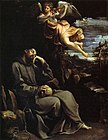Oil on copper

Oil on copper painting is the process of creating artworks by using oil paints with copper as the substrate. This is sometimes referred to as "copper as canvas" because canvas is the most well known surface material used for oil paintings.
History
[edit]Oil on copper paintings were prevalent in the mid sixteenth century in Italy and Northern Europe.[1] The use of copper as a substrate for an oil painting dates back to Medieval times.[2] The Flemish masters and other artists including Jan Breughel the Elder, Claude, El Greco, Guido Reni, Guercino, Rembrandt, Carlo Saraceni, Ambrosius Bosschaert II, Copley Fielding and Vernet painted on copper. They favored copper for its smooth surface which allowed fine detail, and its durability. Copper is more durable than canvas or wood panel as a support for oil painting, as it will not rot, mildew or be eaten by insects. Contemporary painters also use copper as a base for paintings, some of them allowing the metal or patina to show through.[3][4][5][6]
Process
[edit]The old masters prepared the copper for painting first by rubbing it with fine pumice abrasive. The copper surface was then treated with garlic juice which is believed to improve adhesion of the paint. Finally a white or grey ground layer of oil paint was applied as a primer. After drying the copper panel was ready for the artist to begin painting. Later artists used the patina process, in which the copper is oxidized with the use of various acidic solutions, as part of the art work itself. The resulting patina or verdigris includes darkening of the metal, green and blue tones, depending on the chemical solution used. Patina is characterized by beautiful variated patterns and textures which occur on the metal's surface.[6][7][8]
Works
[edit]- Isle of the Dead (painting)
- Francesco St Jerome.
- Mars and Venus oil on copper (1605–1610), (São Paulo Museum of Art, São Paulo)
- The Madonna and Child with Saint Anne and an Angel oil on copper, (ca. 1608–1610) Honolulu Museum of Art
- Dead Frog with Flies.[9]
- Self-portrait of Rembrandt, 1630.
- Scylla by Fillipo Lauri.[10]
Materials
[edit]- Copper substrate
- Oil paint
Techniques
[edit]Spray, brush, splatter, verdigris, roller palette knife.
Oil on copper paintings
[edit]-
The Francesco St Jerome
-
Ambrosius Boschaert II - Dead Frog with Flies
-
Carlo Saraceni - An Angel Appearing to the Wife of Manoah
-
Guido Reni - St Francis Consoled by Angelic Music
References
[edit]- ^ Barratt, Carrie Rebora (1995). John Singleton Copley in America. New York: Metropolitan Museum of Art. p. 118. ISBN 0870997440. OCLC 32085369.
- ^ Historical painting techniques, materials, and studio practice : preprints of a symposium, University of Leiden, the Netherlands, 26-29 June, 1995. Wallert, Arie, 1950-, Hermens, Erma, 1958-, Peek, Marja, 1961-. [Marina Del Rey, Calif.]: Getty Conservation Institute. 1995. p. 98. ISBN 0892363223. OCLC 32131812.
{{cite book}}: CS1 maint: others (link) - ^ Biffis, Mattia (August 2016). "A rediscovered 'St Jerome' on copper by Guido Reni and its early provenance, in The Burlington Magazine 158 (2016), pp. 610-615". The Burlington Magazine. 158: 610–15.
- ^ "Reconstructing a 17th century Flemish flower painting". Art Conservation in Action. 2016-05-31. Retrieved 2018-12-10.
- ^ "Oil on Copper | Artsy". www.artsy.net. Retrieved 2018-12-10.
- ^ a b "art process of oxidizing copper and then painting upon it with oil colors". hawkstudio.com. Retrieved 2018-12-10.
- ^ "How to Paint on Copper | Preparing Copper Plate by Candice Bohannon". Artists Network. 2012-04-04. Retrieved 2018-12-10.
- ^ "Art Process - COPPERHAND Studio". copperhand.com. Retrieved 2018-12-10.
- ^ Waters, Florence (2013-03-06). "Dead frog painting that rots before your eyes". ISSN 0307-1235. Retrieved 2018-12-11.
- ^ "Mermaid Monday: Scylla – Beautiful Naiad Turned Sea Monster". CryptoVille. 2014-08-11. Retrieved 2018-12-11.
External links
[edit] Media related to Oil on copper at Wikimedia Commons
Media related to Oil on copper at Wikimedia Commons




